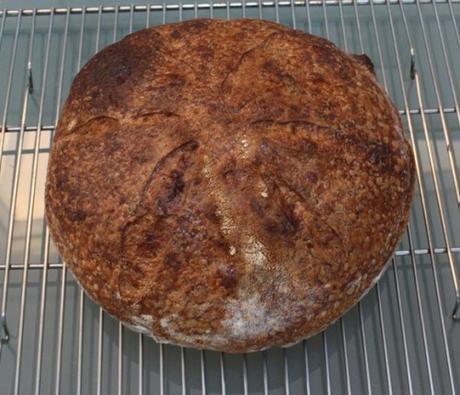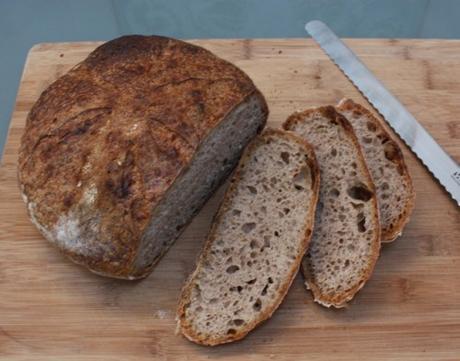 If I said making really good bread at home takes Herculean effort you'd probably stop reading here. But wait! Baking an outstandingly crusty, chewy, fragrant and flavorful boul e (French for ball) is doable. Yes, it's a little involved, and you do have to plan ahead, but it is well worth it. Fact.
If I said making really good bread at home takes Herculean effort you'd probably stop reading here. But wait! Baking an outstandingly crusty, chewy, fragrant and flavorful boul e (French for ball) is doable. Yes, it's a little involved, and you do have to plan ahead, but it is well worth it. Fact.

But here's the thing: While it takes a lot of words to describe the step-by-step sequence of techniques, when all is said and done it's just a lot of slapping and stretching and waiting.
A note about the third photo: In step 9 you line a colander with a dish towel dusted with flour. This one received a liberal amount of flour, which accentuated impressions of the holes in the colander, making this nice flower pattern. You can create your own signature pattern with the slashes on the top.
It goes without saying that using a KitchenAid stand mixer is a must. (Literally, the BA recipe doesn't mention this, but it's essential.)
Here are two links to check out while you wait for the dough to rise: The boule to which all boules aspire can be found at Paris's famed boulangerie Poilâne. And the best way to visit Poilâne is a culinary walking tour with Paule Caillat's Promenade Gourmandes. The time I went she took me down to the bakery below the store. Kind of like a very clean cave. Old stone walls, warm by the ovens, cooler in the outer chambers, with a big chute that the flour came down. Kind of gnarly and charming at the same time.

Recipe lifted from the pages of Bon Appetit magazine
Poolish (bread starter)
1/8 teaspoon active dry yeast
117 grams (3/4 cup plus 2 Tablespoons) whole wheat flour
75 grams (2/3 cup) rye flour
42 grams (6 Tablespoons) bread flour
Dough
103 grams (3/4 cup) whole wheat flour
412 grams (3 cups plus 1 Tablespoon) bread flour, plus more for dusting
17 grams (2 Tablespoons) Diamond kosher salt
- Make the poolish: Combine yeast and 300 grams (1 1/4 cups) room-temperature water in the bowl of a stand mixer. Take the temperature of your kitchen - between 72 degrees and 74 degrees is ideal for fermentation. If your kitchen is running hot, use cooler water. If it's a bit colder, use warm water. Add all the flours and mix with a wooden spoon until no dry spots remain. Cover with plastic wrap and let sit at room temperature until poolish is mature; the surfaces will be very bubbly, 14 - 18 hours.
2. Do the float test: Drop a pinch of poolish into a small bowl of room temperature water. If it floats, it's mature and you're good to go. If it sinks wait 30 minutes and test again.
3. Mix dough and start autolysis: Combine 300 grams (1 1/4 cups) room temperature water into poolish with a sturdy wooden spoon. Then add whole wheat flour and 412 grams (3 cups + 1 tablespoon) all-purpose flour and mix until no dry spots remain. Cover dough with plastic wrap and let sit 2 hours. (This process, called autolysis, starts to develop the all-important gluten, giving the dough structure and chew.)
4. Add salt and mix: Evenly sprinkle salt over dough, then add 65 grams (1/4 cup plus 1 teaspoon) room-temperature water and mix with dough hook on medium-low speed. The dough should start to develop a shape and cling to hook after a minute or two. Increase speed to medium-high and mix until almost all the dough clings to hook and clears the side of the bowl, 8 - 12 minutes. Cover with plastic wrap and let sit 15 minutes to let dough relax.
5. Do the flap and fold: Turn out dough on a clean surface. Holding a flexible bench scraper in one hand, quickly lift dough to eye level then slap it down on surface in one swift deliberate motion. As you propel dough downward let it fall off the ends of your hands and fold over onto itself. The dough will be sticky but it will want to stick to itself more than your hands. Start slowly to avoid flying dough bits, then increase the intensity of your motion as the dough starts to firm up. Slap and fold 10 - 12 minutes, occasionally scraping bits of dough from surface with bench scraper. If you're not slightly winded by the time the dough is ready you're doing it wrong. [Your shoulder will be tired too.] This important step builds gluten and strengthens the dough which helps give the finished loaf a nice open crumb.
6. Do the windowpane test: Pinch off a small piece of dough and stretch it between your thumbs and index fingers on both hands. The dough should be able to stretch thin enough to let light through without breaking. If it splits or tears the gluten is not yet developed enough. Continue slapping and folding another 2 minutes and test again.
7. Let the dough bulk ferment: Place dough in a large clean bowl and cover with plastic wrap; let sit 30 minutes. Starting from one side, use a bench scraper to lift edge of dough, stretching it up and out of the bowl at least 12" and shaking back and forth to encourage lengthening, then fold back onto itself. Rotate the ball 90º. Repeat stretching process three more times, rotating the bowl after each turn. Cover and rest another 30 minutes. Repeat process two more times, resting dough 30 minutes in between each full turn. This rebuilds gluten and feeds the yeast during fermentation. Cover with plastic wrap and let sit in a warm spot until nearly doubled in size, 30 - 60 minutes. Dough should look puffed and bubbly on the surface.
8. Do the finger test: To test if your dough is fermented poke it with an oiled finger; the dough should spring back slowly but still hold a slight indentation.
9. Preshape and bench rest: Turn out dough onto a lightly floured surface. Do a final series of 4 folds bringing edges into the center. Turn dough over using bench scraper to help you, so seam side is down. Lightly dust with more flour and cover with a kitchen towel. Let rest until dough is puffed and surface is dotted with a few bubbles, 20 - 50 minutes. Line a 9″ round colander with a clean kitchen towel and dust towel with an even layer of flour.
10. Shape the boule: Uncover dough and dust with a bit more all-purpose flour. Use bench scraper to push edges of dough toward the center to gather into a ball. Cup scraper and free hand around far side of dough and gently pull ball towards you, dragging dough several inches across work surface and rotating slightly. Repeat dragging motion several times, occasionally moving dough back to the center of surface. The friction against the surface will help tighten the gluten over the dough, creating a smooth dome. Lightly flour top of dough; turn over with bench scraper and quickly transfer seam-side up to prepared colander. Cover with plastic, chill 1 - 2 days. The longer the bread sits the more complex the flavor will be, but don't chill longer or the yeast may die.
)
11. Bake bread: Place an oven rack in lower third of oven and set a 3 1/2 - 5 1/2 qt. Dutch oven in center of rack. Set your oven as high as it will go (you want it between 450° and 500°.) Let pot preheat at least 40 minutes. (If the handle on the lid is made of plastic, unscrew, remove, and plug hole with a small piece of foil.) Uncover dough and dust surface with rice flour. Cut a round of parchment paper so it's slightly larger than dough; place over top. Remove pot from oven and set on stove top. Working on stove next to Dutch oven, invert dough onto a plate. Parchment side will be down. Use a lame or a razor blade taped to an ice pop stick to slash dough into desired patterns using swift and deliberate strokes. Cut at least a half-inch deep into the dough. Working quickly and wearing mitts on both hands, slide dough and parchment into center of pot. Cover pot and bake bread 15 minutes. Remove lid and continue to bake, rotating pot halfway through until crust is very well done - approaching the edge of burnt - 30 to 40 minutes. Carefully transfer bread to a wire rack. When its cool enough to handle remove parchment.
2. Wait to slice: Resist the temptation to cut into that just-out-of-the-oven loaf. Trust us. You want to wait at least a couple of hours so the starches in the bread have time to set. This gives the bread a better texture. If you're dead set on eating it warm, reheat part of the loaf in a 300° oven (which will also revive the crust), then slice.
Phew!
Well worth it friends, well worth it.

